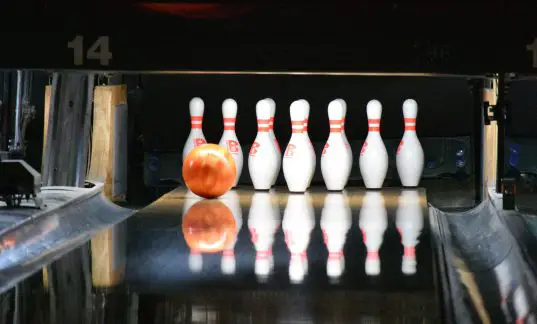If you’re new to the world of bowling, you’re probably not familiar with the different oil conditions and patterns used at bowling alleys around the world. If that’s the case, you’re in for a bit of a learning experience.
Different bowling alleys and different bowling tournaments use different oil patterns for various events and open bowling windows. Professional-level bowling tournaments opt for longer or shorter oil patterns that have varied oil densities and complex transitions between wet and dry.
Amateur-level tournaments might use similar oil patterns while knocking down the difficulty level a notch or two.
However, the most common oil pattern used in bowling is the house oil pattern. If you’ve walked into a bowling alley on a random weekday, rented some shoes, and got to work, you’ve likely played on this crowd-favorite oil pattern before.
What is a house pattern at a bowling alley?
A house oil pattern uses just enough oil on the edges of a bowling lane to maintain traction while concentrating more oil in the middle part of the lane. The oil volume gradually increases from gutter to the middle of the lane surface in a typical house oil pattern.
While each bowling alley might apply a house oil pattern differently, most house patterns are around 32 feet in length and buffed to 40 feet. That means that a house pattern covers just over half of the lane space from the foul line to the pin deck.
How is a bowling ball affected by house oil patterns at a bowling center?
House oil patterns do wonders for bowling balls’ reaction times and strike capacities. Because of the heavy concentration of oil in the middle of the lane and the drier lane conditions on the outside part, it’s easier to find a groove in the center of the lane headed towards the pin pocket. If you make a physical mistake based on footwork or your throw mechanics, the extra oil in the center of the lane can help you track back towards optimal pin impact.
A straighter player will love how a house pattern allows them to play inside and groove throws down the center of the lane. Typically, those players with a straighter game miss less on house patterns than they would in tougher conditions.
And for hook-dominant bowlers, the consistency and length of a house oil patterns has positive effects on how and when a ball hooks. Smart bowlers can store energy longer for big, booming backend crashes by calibrating their hooks with a stronger ball. There’s a bit less miss room on the edges with less oil available, so oftentimes more compact hooks are rewarded.
How are bowling scores usually affected by a house shot on bowling lanes?
Generally, bowlers score higher on house oil patterns than any other type of pattern. When you bowl on a house pattern, the oil is placed in such a way to forgive mistakes and funnel the ball towards the pin pocket. A ball rolled with proper form on a house oil pattern is more likely to lead to high scores than one that gets lost in a pattern that’s longer (or shorter) and more complex.
Practice time spent with a house oil pattern is usually rewarded with a pronounced increase in overall bowling average. It’s easy to watch the reaction of your ball on a house pattern during practice frames, noting your mechanical mistakes and placement errors. Most bowlers find a groove by starting their reaction on the second arrow, moving it towards the third arrow and into the pin pocket.
Straight-line bowlers tend to do much better with house patterns than other types. As for hook bowlers, it depends on their ability to adjust and tweak their spin to meet the relatively straightforward demands of a house oil pattern.
Are house oil patterns used for open bowling?
Unless you’re bowling at a specialized bowling center with a professional bent, you’re likely to play on a house oil pattern. Some competitive leagues opt for a house shot to level the playing field a bit. Other leagues adopt shorter or longer oil patterns to increase the challenge.
However, open bowling at 2pm on a random Wednesday is usually done on a house oil pattern. That’s because house patterns are much more playable for bowlers of all ages, skill levels, and handicaps. The lane conditions are perfectly calibrated for the largest percentage of bowlers, allowing everyone to do their thing and find their way to strikes and spares.
Frequently Asked Questions
Is my local house oil pattern the standard oil pattern for bowling centers around the world?
Most bowling centers use a variation of the house oil pattern for open bowling and most of their special events. However, that doesn’t meant that your local bowling alley’s house pattern is the same as the one at the alley some miles away. There are variances in the exact oil density of the pattern, how quickly it transitions from wet to dry, and the overall length. Typically, the house oil pattern is the standard pattern used for bowling across the globe. But, there are little nuances that can be worked into a house pattern that an alley operator might choose to include. It just depends on what they’re looking for and what they think is best for their clientele.
How do long oil patterns and light oil patterns different from house patterns?
House oil patterns are applied with a simple goal in mind — to funnel throws towards the center of the lane and into the pin pockets. In comparison, complex oil patterns that are longer or shorter in length may not be constructed to keep the ball in the middle part of the lane. They might have jarring transitions that reward play on the edge of the lanes, or sudden decreases in density that challenge even the most expert of bowlers. Talk to your local bowling alley operator about their non-standard oil patterns and the reasoning behind them. With a little bit of insight and a lot of practice frames, you’ll be able to tackle complex lane conditions with aplomb!
What is the best oil pattern for recreational bowlers?
The house oil pattern is, by far, the best oil pattern for recreational bowlers. A house shot is calibrated to turn bad throws into okay throws and okay throws into strikes. Its forgiving nature leads to better scores for bowlers of all skill sets. And it’s easy-to-understand setup is easy to conquer for bowlers who understand the physics and effects of different oil densities. With the right approach and the right body mechanics, casual bowlers can do major damage on house oil patterns.
What kinds of bowling balls work best with a house oil pattern?
It depends on your throwing style. If you’re a hook-dominant bowler, reactive resin bowling balls are the way to go. We recommend a reactive pearl or reactive hybrid bowling ball with strong durability and an average level of porousness. For straight-line bowlers, a polyurethane or urethane ball is a smart play. When slotted into the deeper oil in the middle of the lane, these less-porous bowling balls tend to stick and slide into your pin pocket of choice.
Final Thoughts
Easy to learn and fun to conquer, the house oil pattern is a bowler’s first step towards strike success. If you can read a house pattern and use its setup to your advantage, you can boost your scores in dramatic fashion. And once you learn the ins and outs of a house pattern, you’ll be able to tackle other patterns with much more confidence.

